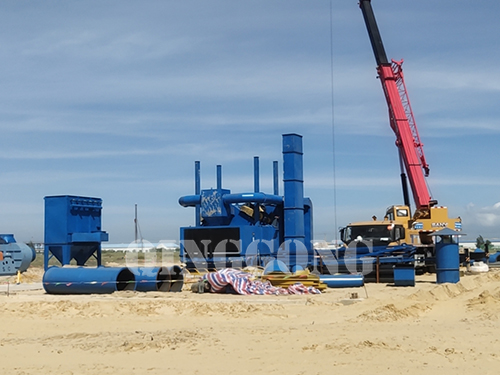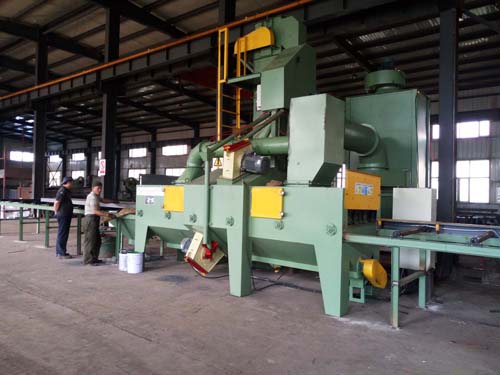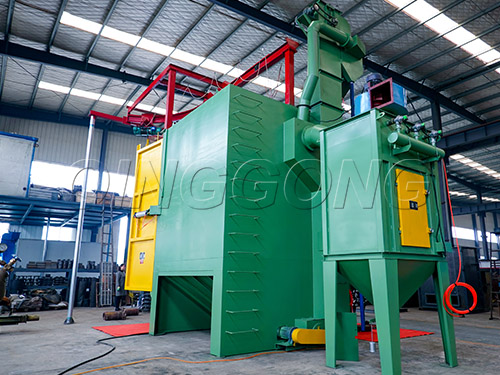The steel structure we use will cause rust stains after being placed for a long time, and there will be various dirt on the surface. Therefore, rust removal is a major process in the production of steel structures. If it is not handled well, it will directly affect the quality and quality of the steel structure. Quality shortens the maintenance cycle of steel structures or affects service life, and sometimes brings structural safety issues during the service life of steel structures.
1. Construction features: The selection of appropriate steel shots ensures the surface roughness of the steel after rust removal and improves the adhesion of the paint film during painting. The method of determining the speed of the conveying roller is adopted to ensure the quality of rust removal while saving processing time, improving efficiency, and reducing the cost of rust removal. By reasonably adjusting the projection angle and shutting down of the shot blasting device, energy consumption can be reduced and the service life of the shot blasting equipment can be prolonged. The operation is simple, the technology is mature, the economy is reasonable, the practicability is strong, and it has good promotion and application value.
2. Scope of application: The h beam cleaning equipment is suitable for cleaning the surface of the steel, removing the oxide scale and rust of welded H steel, steel, profile, steel pipe, and the construction of friction surface treatment of steel structure nodes.
3. Process principle: Steel structure shot blasting rust removal is to use the shot blasting device of the shot blasting machine to throw dense steel shots from different directions on the surface of the steel to remove the oxide scale, rust layer, and dirt on it and obtain Derusting method with certain surface roughness. This process controls the surface roughness by selecting the appropriate types of steel shots and different gradations of steel shots. Different rust grades of steel surfaces use different conveyor roller speeds to control the ejection time. The method adopts the method of adjusting the projection angle and shutting down the projectile to control the energy consumption to achieve the purpose of ensuring the rust removal level, improving the rust removal quality, improving production efficiency, saving energy consumption, and reducing production costs.
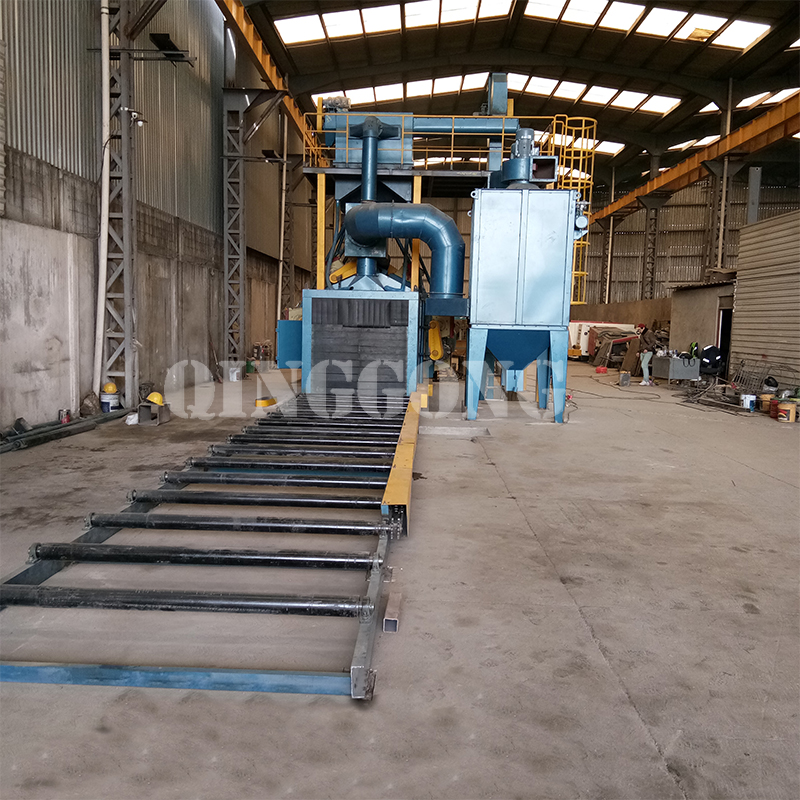
4. Process flow and operation points:
1) Process flow: steel shot selection and gradation → shot blasting time control → according to the structure and height of the workpiece, adjust the shot angle of the shot blasting equipment → hoist the component to the roller table → start the spraying → lift the component to lift the roller table → Inspection and acceptance.
2) Operating points: ① Selection and grading of steel shot: The surface roughness of steel structure before painting has a great influence on the adhesion of the coating, the surface roughness is too small, and the paint film lacks the necessary anchor points after it is fully cured The adhesion of the coating is small, the coating may be damaged early, peeling, cracking or delamination, etc., if the surface roughness is too large, and the amount of the paint film is fixed, the thickness of the paint film will be unevenly distributed, especially at the peak of the wave. The thickness of the paint film is lower than the design requirements, causing early corrosion. In addition, air bubbles are often trapped in the deep valleys, which will become the root cause of the paint film blistering. Therefore, the surface roughness of the rust-removed steel must be adjusted during construction. control. The type, shape, size, and gradation of steel shots are very important factors that affect the surface roughness after rust removal. Therefore, the selection and grading plan of steel shots has been worked out after repeated trials. ② The selection and grading of steel shots should be such that the surface roughness of the steel after polishing should be controlled within a certain range, and the surface roughness profiler should be used for testing.
5. Control of shot blasting time:
1) The workpieces are placed on the conveying roller, and the component is slowly transported to the ejection chamber at a certain speed. The ejector whose end or end is activated will project the steel shot to the surface of the component from the time it exits the ejection chamber and leaves the steel. The time for blasting the surface is the shot blasting time. The shot blasting time is controlled by controlling the speed of the conveyor roller to achieve the rust removal effect.
2) For different rusted steel surfaces that are shot by certain steel shots and reach the same rust removal level, the speed of the conveying roller table used for severe corrosion should be lower, and the speed of the conveying roller table used for less serious use should be higher. When the steel surface of the same corrosion grade is projected by a certain steel shot, when it reaches different rust removal grades, the speed of the conveyor roller table with high rust removal grade is lower, and the speed of the conveyor roller table with low rust removal grade is higher. Based on the above principles, combined with the rust condition of the derusted steel surface and the derusting grade required by the design, a method for determining the speed of the conveying roller table is formulated.
3) After the basic interval speed is determined, comprehensively consider the steel material, the wear of steel shots, or the supplementary steel shots, the smaller the surface hardness of the material is, the larger the surface hardness is, and the larger is just after the shot is added. Small value, when the steel shot wears seriously and tends to fill the shot, the large value is used to determine the speed of the conveying roller table. According to the structure and height of the workpiece, adjust the shot angle of the industrial shot blasting machine: because shot blasting rust removal is to hit the thrown steel shot on the surface of the steel to achieve the deflection in the table, observe whether the workpiece is off-track, and adjust it in time; the speed of the roller table is controlled Transport in strict accordance with the requirements. The machine should regularly remove the waste in the separator and dust collector during operation to ensure the normal operation of the equipment. Pay attention to whether the vibration and sound of the shot blaster are normal during operation, and the bearing and motor are heating up. When there is an abnormality, stop the machine for inspection, troubleshoot the fault or replace the blade. After the components are derusted, they should be lifted away from the roller conveyor with a truss crane in time and placed in the designated position, and the finished product should be protected.
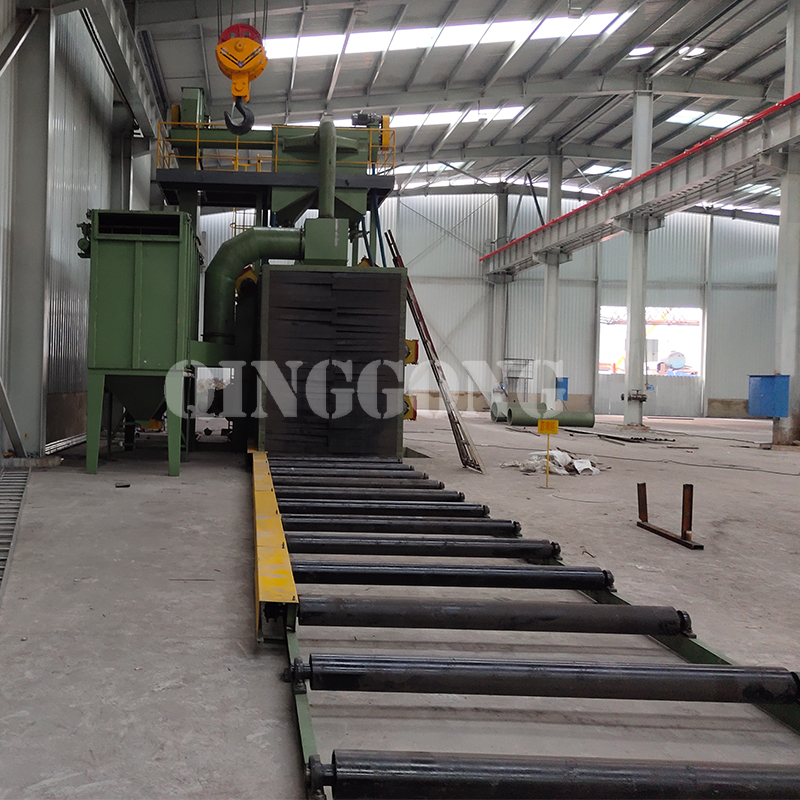
 EN
EN
 fr
fr  de
de  es
es  it
it  ru
ru  pt
pt  ar
ar  th
th  pl
pl  ro
ro 
